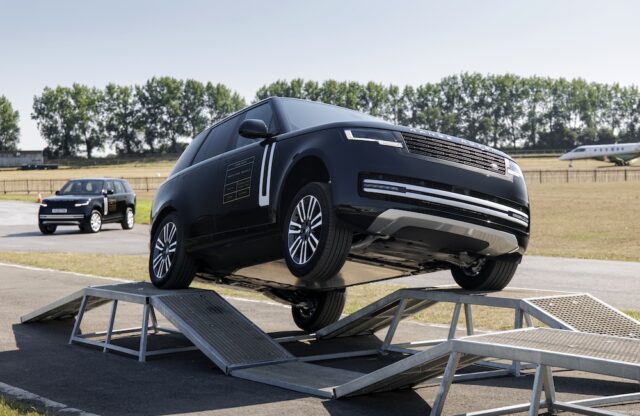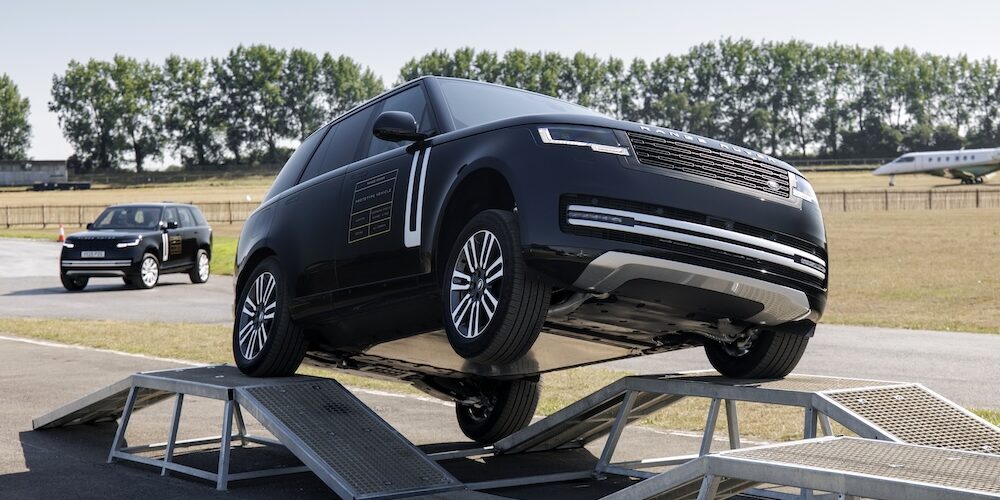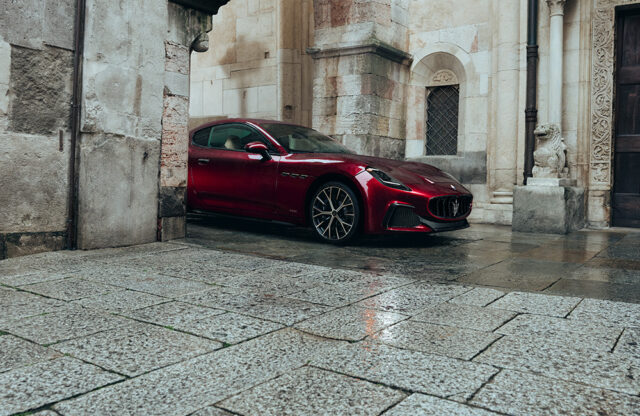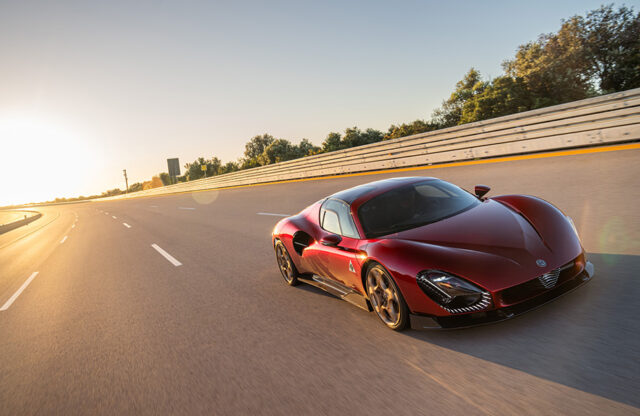More than ten years ago, probably closer to 15, a senior Land Rover engineer explained to me how suited electric propulsion could be for off-roading. He talked about the torque and controllability and even surmised that in-wheel motors could be used, controlling each one separately to perfectly balance power across the four wheels.
Much more recently, Land Rover announced that it would indeed be producing an all-electric Range Rover; here it is, in prototype form, which we were able to drive on an obstacle course at Goodwood Motor Circuit. It doesn’t have in-wheel motors but it probably has a lot more range and perhaps less weight than that engineer in the 2000s was imagining. The 550PS of power and 850Nm of torque is surely also more than was imagined a decade or so ago.
The crucial point to understand about the current generation Range Rover is that it was designed to accept all three varieties of powertrain: internal combustion (ICE); plug-in hybrid (PHEV): and fully electric (EV). This means that the same body can be dropped onto any of the three platforms, all of which have exactly the same suspension pick-up points and similar weight and ground clearance. All will be built on the same production line in Solihull.
According to one of the senior development engineers, the ICE is the lightest with the most ground clearance, the PHEV is the heaviest with the least ground clearance. The EV is said to sit in the middle of the two – the difference in clearance is said to be 30mm less than the ICE model’s, while wading depth is still 900mm.
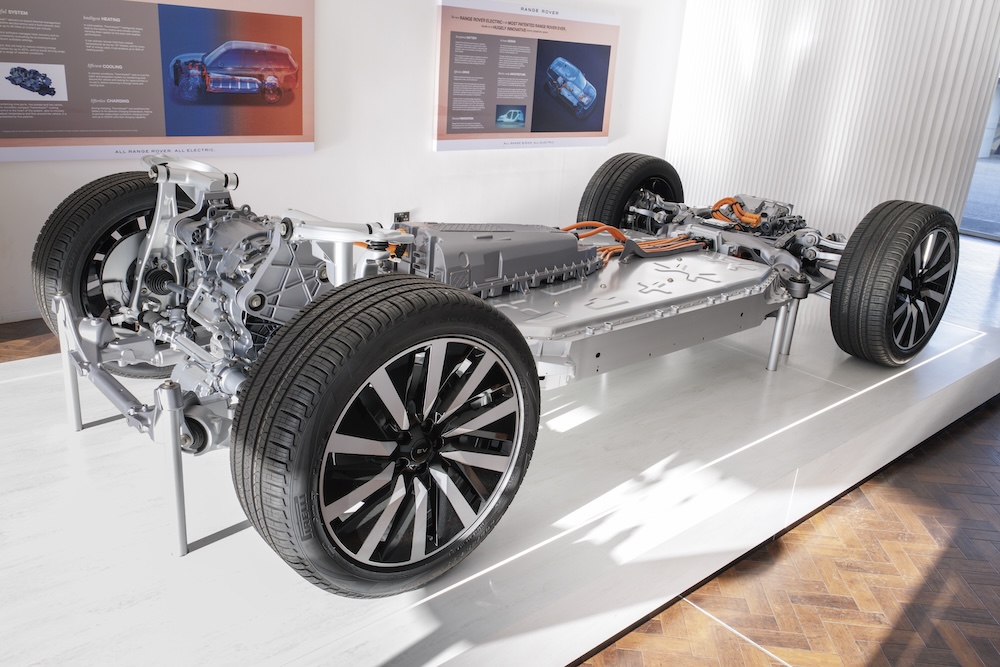
It’s for this reason that the EV platform you see here looks a little different from most, with a double layer battery instead of the usual single layer of cells, taking up less width than you’d normally expect but with the inverter built in the shape of a conventional gearbox to fit within the usual ICE transmission tunnel, and permanent magnet motors front and rear where you’d expect an engine and a differential. As you’d hope, the 800 volt, 344 prismatic cell battery is fully encased and waterproofed, with a perfectly flat thick alloy protective plate protecting it underneath.
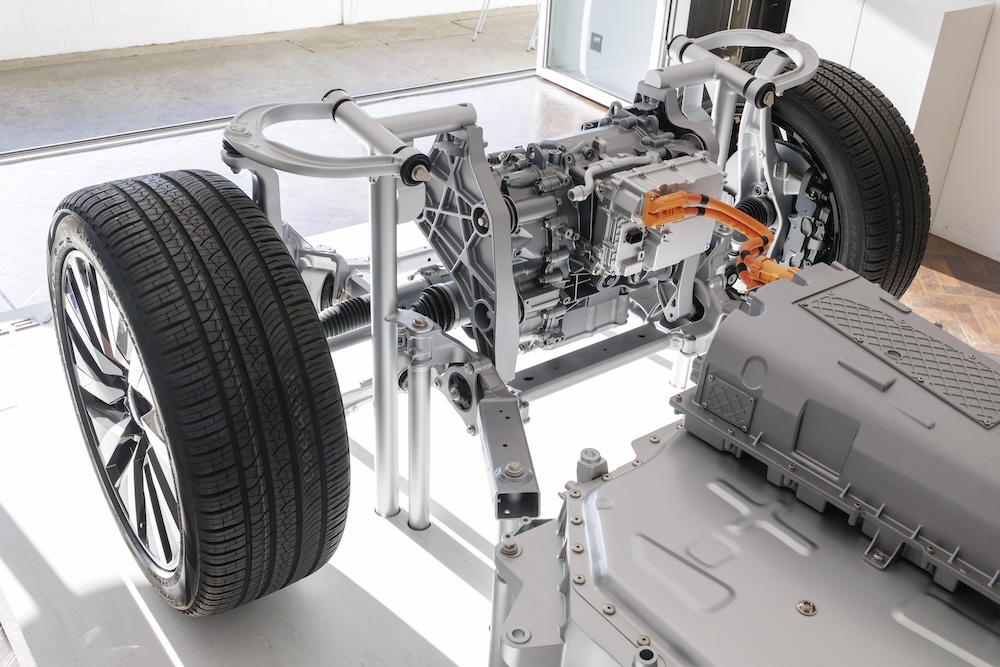
What can it do? Almost everything that the ICE and PHEV versions can do but more quietly and smoothly. ‘Almost everything’? Well, if you’re in the market for one of the top-end V8 editions, what the EV can’t do is make that lovely muted woofle that just says power, torque and high fuel consumption. But it is likely to match the output figures even if it can’t quite produce the soundtrack.
Now, you should note that we drove the EV only at slow speeds and only on tarmac and man-made obstacles. There’ll be more to come when the first production vehicles emerge. But what’s unsurprisingly apparent is that Range Rover Electric is luxuriously whisper-quiet and smooth, and yet capable of all those uncanny off-roading tricks that leave occupants impressed and perhaps a little scared (I’ve not met a passenger yet who doesn’t baulk at the idea of a steep climb that gives nothing but sky in the windscreen, swiftly following by a descent that leaves them hanging in their seat belts as the view through the windscreen suddenly turns to terra firma).
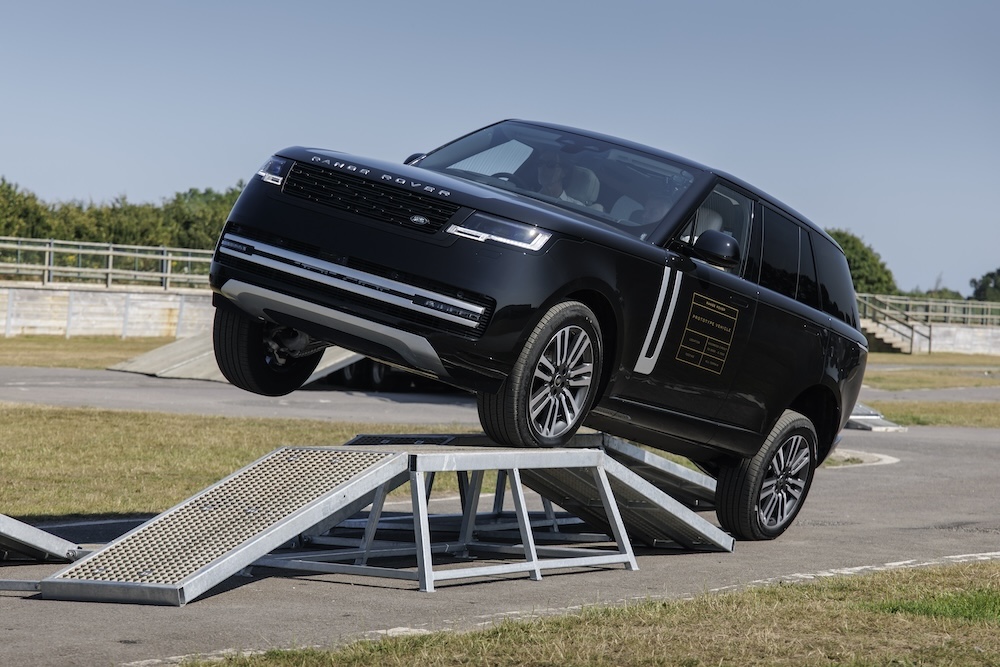
Of course the EV manages all the tricks perfectly. The ramps that leave first a front wheel and then a rear wheel dangling 4 ft in the air? No problem, just a tiny chirrup from a rear tyre giving the game away as it starts to lose grip before the four-wheel drive system sorts itself out. The useful bit here is to be able to engage single pedal mode, so that the Range Rover gently stops as soon as the accelerator is lifted. Wonderful both for tricky rock climbing and for the stop-start traffic jams of the urban jungle.
The steep climb and descent ramp over the top of a shipping container? That’s the one that feels the most daunting, and the comedians at Land Rover have added a slippery patch on one side of the ramp that’s hosed with water to add to the challenge, requesting that we stop on the slippery patch, halfway up, then pull away again. The Range Rover Electric completes the task perfectly. Obviously I’m not going to say that little skill is needed by the driver… but it does make the task much easier (as does the instructor sitting in the passenger seat).
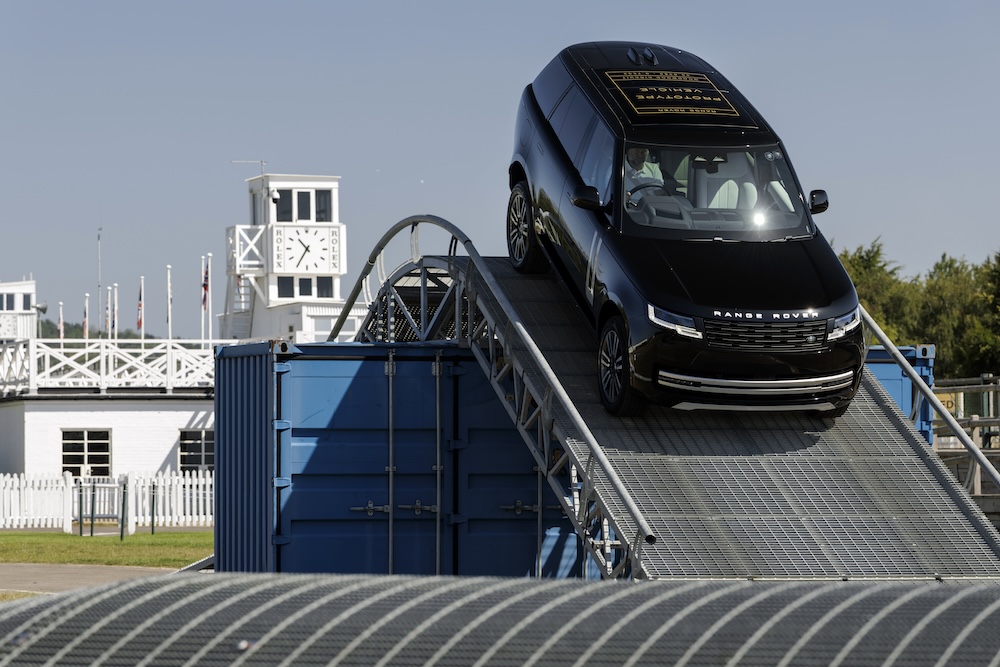
The descent does take away the need for skill and luck, because the familiar Hill Descent Control simply crawls the vehicle down the ramp with complete control, stopping at the bottom. Even if you’re not planning to drive anywhere via steep, slippery ramps, you will at least have the confidence to traverse slippery wet grass hills that never fail to floor conventional vehicles.
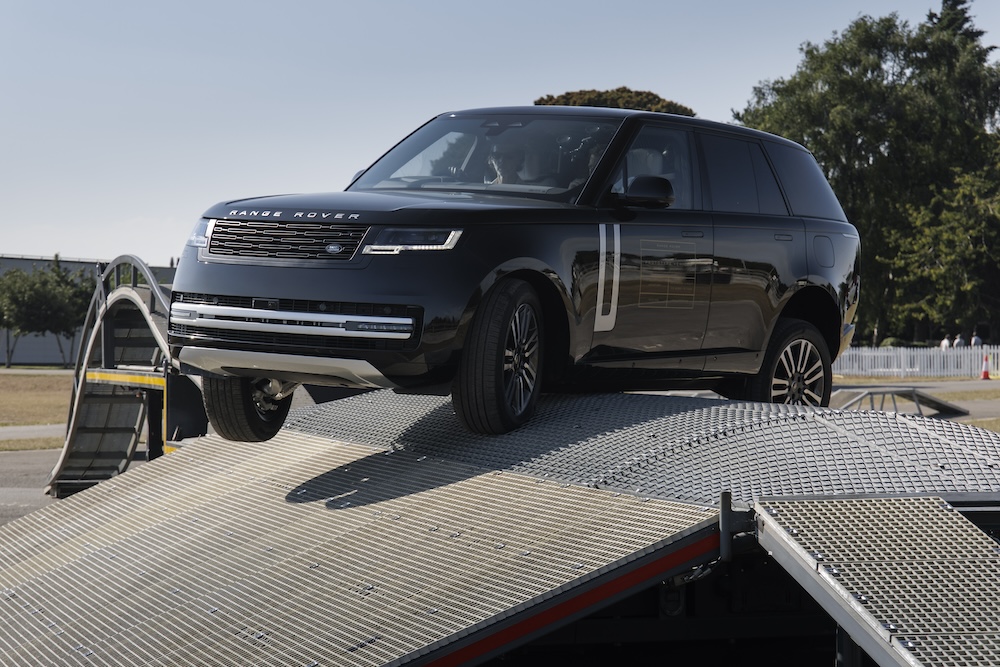
Another ramp, this one tackled at an angle, demonstrates the torsional rigidity of the Range Rover Electric, which is actually stiffer than the ICE version due to the inherent strength of the battery. A quick push of the accelerator away from the ramp shows the expected instant torque and smooth-silent getaway, followed by the equally silky glide to a half when the accelerator is lifted.
What we found even more interesting – because so much of the above is absolutely as you’d expect from a Range Rover – were the technical briefings. There are apparently over 100 patents taken out on the Range Rover Electric, which will be used if and when the EV platform is extended across other models. The Range Rover Sport shares the same ICE platform so that’s entirely feasible for EV, if it’s deemed appropriate for the sportier model, for example.
In fact, the Electric uses the twin-chamber air suspension of the Range Rover Sport anyway, and – because it has a lower centre of gravity than any other Range Rover, it also does without the active anti-roll bars of the standard Range Rover. This should give it better ride quality.
The most important innovations are in the way that heat is moved around the battery system and the interior of the vehicle, to optimise battery performance and charging, as well as minimising energy loss when cooling and heating the cabin. Heat is harvested from the battery, the motors, radiators and more to a level of complexity rarely seen before, which is said to have reduced heating energy consumption by up to 40 percent.
That, of course, is crucial to the range, which will make or break Range Rover Electric sales, regardless of how far its buyers actually drive on their average journeys. The battery has 118kW of useable power (542bhp and 647lb ft of torque) and the vehicle is likely to weigh about 2800kg, so what will range be? We think around 300 miles in the most favourable conditions, with extremely fast charging available. Towing, though, will pull that right down – and capacity reduces from 3.5 tonnes to 2.5 tonnes for the EV.
The drivetrain, too, breaks new ground, able to distribute rear torque from 100% to 0% to prevent loss of traction. The system can also control motor speed within 50 milliseconds and manage slip up to 100 times quicker than an ICE vehicle equivalent, which makes for better traction control and grip.
Does electric propulsion take anything away from the full Range Rover experience? Only the soundtrack, the sense of environmental unease (if you’re comparing with a V8 petrol) and towing capacity. Does it add anything? Even more impressive torque response, luxury feel, a touch of range anxiety if you’re prone to that (or somewhere remote) and the soundtrack (if you’re comparing with a diesel…).
The Land Rover crew on hand were very keen to point out that this is not the electric Range Rover; it’s the Range Rover Electric – because they say it is absolutely true to the 55-year-old model. On this evidence, that seems a fair point, and the 65,000 expressions of interest from potential customers by mid-July 2025 echo that.
